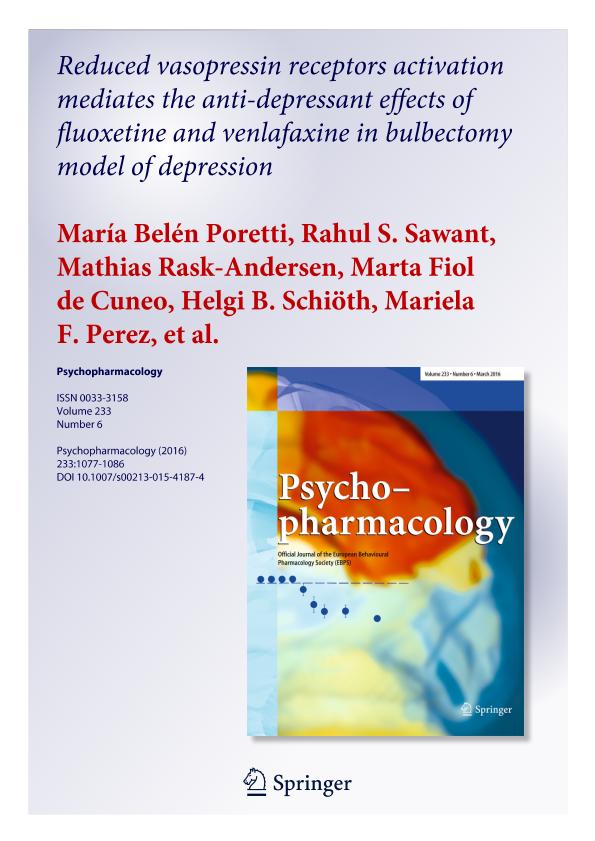Artículo
Reduced vasopressin receptors activation mediates the anti-depressant effects of fluoxetine and venlafaxine in bulbectomy model of depression
Poretti, María Belén ; Sawant, Rahul S.; Rask Andersen, Mathias; Fiol, Marta Haydee
; Sawant, Rahul S.; Rask Andersen, Mathias; Fiol, Marta Haydee ; Schioth, Helgi B.; Perez, Mariela Fernanda
; Schioth, Helgi B.; Perez, Mariela Fernanda ; Carlini, Valeria Paola
; Carlini, Valeria Paola
 ; Sawant, Rahul S.; Rask Andersen, Mathias; Fiol, Marta Haydee
; Sawant, Rahul S.; Rask Andersen, Mathias; Fiol, Marta Haydee ; Schioth, Helgi B.; Perez, Mariela Fernanda
; Schioth, Helgi B.; Perez, Mariela Fernanda ; Carlini, Valeria Paola
; Carlini, Valeria Paola
Fecha de publicación:
03/2016
Editorial:
Springer
Revista:
Psychopharmacology
ISSN:
0033-3158
e-ISSN:
1432-2072
Idioma:
Inglés
Tipo de recurso:
Artículo publicado
Clasificación temática:
Resumen
Rationale: In response to stress, corticotropin releasing hormone (CRH) and vasopressin (AVP) are released from the hypothalamus, activate their receptors (CRHR1, CRHR2 or AVPr1b), and synergistically act to induce adrenocorticotropic hormone (ACTH) release from the anterior pituitary. Overstimulation of this system has been frequently associated with major depression states. Objective: The objective of the study is to assess the role of AVP and CRH receptors in fluoxetine and venlafaxine effects on the expression of depression-related behavior. Methods: In an animal model of depression (olfactory bulbectomy in mice, OB), we evaluated the effects of fluoxetine or venlafaxine (both 10 mg/kg/day) chronic administration on depression-related behavior in the tail suspension test. Plasma levels of AVP, CRH, and ACTH were determined as well as participation of their receptors in the expression of depression related-behavior and gene expression of AVP and CRH receptors (AVPr1b, CRHR1, and CRHR2) in the pituitary gland. Results: The expression of depressive-like behavior in OB animals was reversed by treatment with both antidepressants. Surprisingly, OB-saline mice exhibited increased AVP and ACTH plasma levels, with no alterations in CRH levels when compared to sham mice. Chronic fluoxetine or venlafaxine reversed these effects. In addition, a significant increase only in AVPr1b gene expression was found in OB-saline. Conclusion: The antidepressant therapy used seems to be more likely related to a reduced activation of AVP rather than CRH receptors, since a positive correlation between AVP levels and depressive-like behavior was observed in OB animals. Furthermore, a full restoration of depressive behavior was observed in OB-fluoxetine- or venlafaxine-treated mice only when AVP was centrally administered but not CRH.
Archivos asociados
Licencia
Identificadores
Colecciones
Articulos(IFEC)
Articulos de INST. DE FARMACOLOGIA EXPERIMENTAL DE CORDOBA
Articulos de INST. DE FARMACOLOGIA EXPERIMENTAL DE CORDOBA
Citación
Poretti, María Belén; Sawant, Rahul S.; Rask Andersen, Mathias; Fiol, Marta Haydee; Schioth, Helgi B.; et al.; Reduced vasopressin receptors activation mediates the anti-depressant effects of fluoxetine and venlafaxine in bulbectomy model of depression; Springer; Psychopharmacology; 233; 6; 3-2016; 1077-1086
Compartir
Altmétricas



